N. Bhatt, M. Amrhein and D. Bonvin
Completed project (2005-2011)
This project investigated and developed appropriate tools that facilitate the analysis of homogeneous and gas-liquid reaction systems. The main contribution was a novel procedure for computing the extents of reaction and the extents of mass transfer for reaction systems with inlet and outlet streams.
Extents of Reaction, Mass Transfer and Flow
 For open homogeneous reaction systems, this project proposed a linear transformation of the number of moles vector into four distinct parts, namely, the extents of reaction, the extents of inlet, the extent of outlet and the invariants, using only the stoichiometry, the inlet composition and the initial conditions.
For open homogeneous reaction systems, this project proposed a linear transformation of the number of moles vector into four distinct parts, namely, the extents of reaction, the extents of inlet, the extent of outlet and the invariants, using only the stoichiometry, the inlet composition and the initial conditions.
For open gas-liquid reaction systems and using only the stoichiometry, the inlet composition, the initial conditions, and the knowledge of the species transferring between phases, a linear transformation of the numbers of moles in the liquid into five distinct parts was proposed, namely, the extents of reaction, the extents of mass transfer, the extents of liquid inlet, the extent of liquid outlet and the invariants. Similarly, a transformation of the numbers of moles in the gas phase into four distinct parts was proposed to generate the extents of mass transfer, the extents of gas inlet, the extent of gas outlet and the invariants.
Minimal State Representation and State Reconstruction
The conditions under which the transformed models are minimal state representations have been derived for homogeneous and gas-liquid reaction systems. Furthermore, using the measured flow rates and the proposed transformations, it was shown how to reconstruct unmeasured concentrations without knowledge of the reaction and mass-transfer rate expressions. It was also shown that the minimal number of measured concentrations equals the number of independent reactions for homogeneous reactors or the number of reactions plus the number of transferring species for gas-liquid reactors.
Incremental Identification
 The incremental identification proceeds in two steps: (i) computation of the extents of reaction and mass transfer from measured data, and (ii) estimation of the parameters of the individual reaction and mass-transfer rates from the computed extents. In the first step, the linear transformation is applied to compute the extents of reaction, mass transfer and flow directly from measured data without knowledge of the reaction and mass-transfer rate expressions. An approach was also developed for the case where concentrations are only available for a subset of the reacting species. In the second step, the unknown rates are identified individually for each reaction or each mass transfer from the corresponding individual extent using the integral method.
The incremental identification proceeds in two steps: (i) computation of the extents of reaction and mass transfer from measured data, and (ii) estimation of the parameters of the individual reaction and mass-transfer rates from the computed extents. In the first step, the linear transformation is applied to compute the extents of reaction, mass transfer and flow directly from measured data without knowledge of the reaction and mass-transfer rate expressions. An approach was also developed for the case where concentrations are only available for a subset of the reacting species. In the second step, the unknown rates are identified individually for each reaction or each mass transfer from the corresponding individual extent using the integral method.
Keywords
Incremental identification; Transport phenomena; Extents of reaction; Extents of mass transfer; Extents of inlet/outlet flow; Linear transformations; Model reduction; Minimal state representation; Homogeneous reactors; Gas-liquid reactors.
Publications
[epfl_infoscience url=”https://infoscience.epfl.ch/publication-exports/2199/?ln=en”]